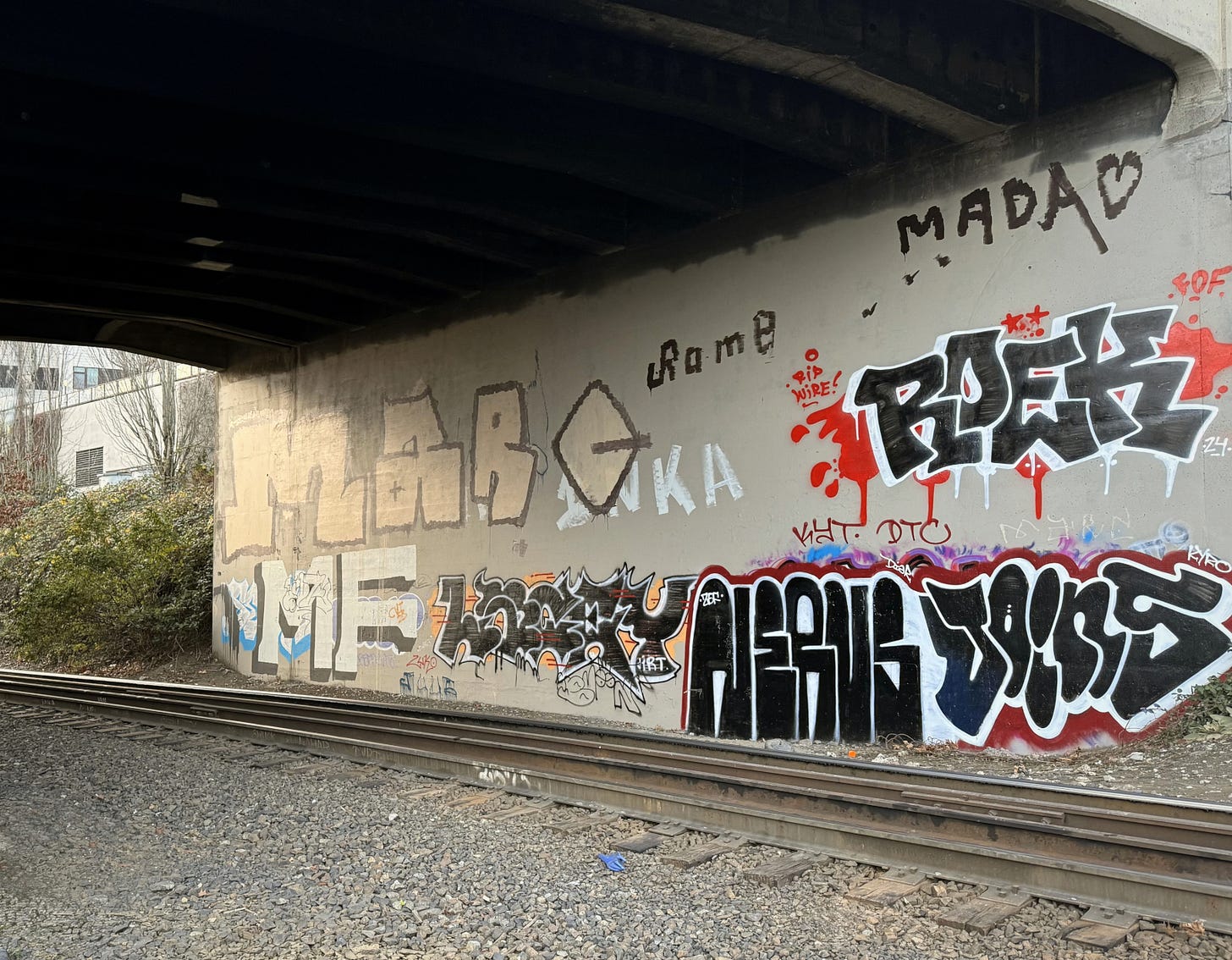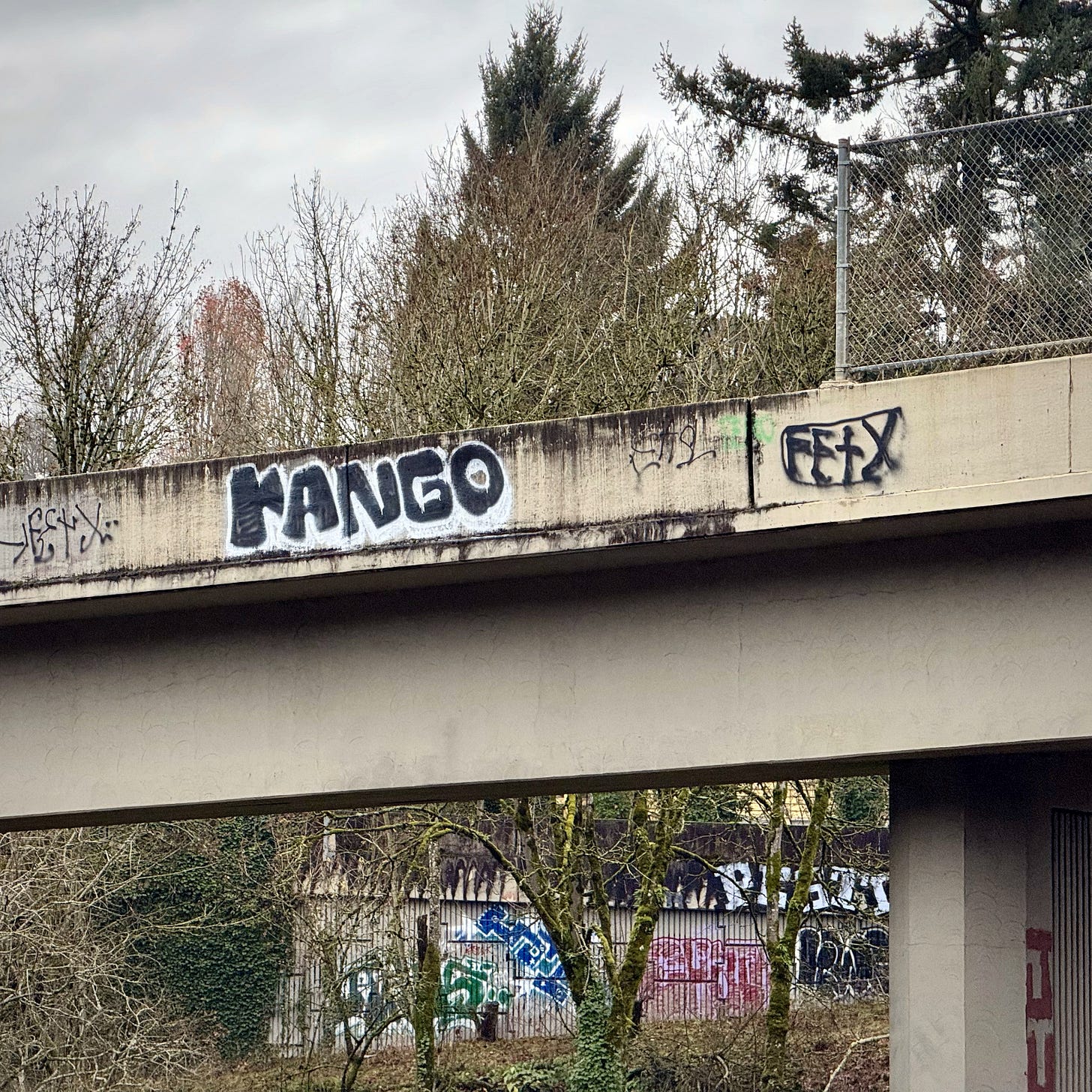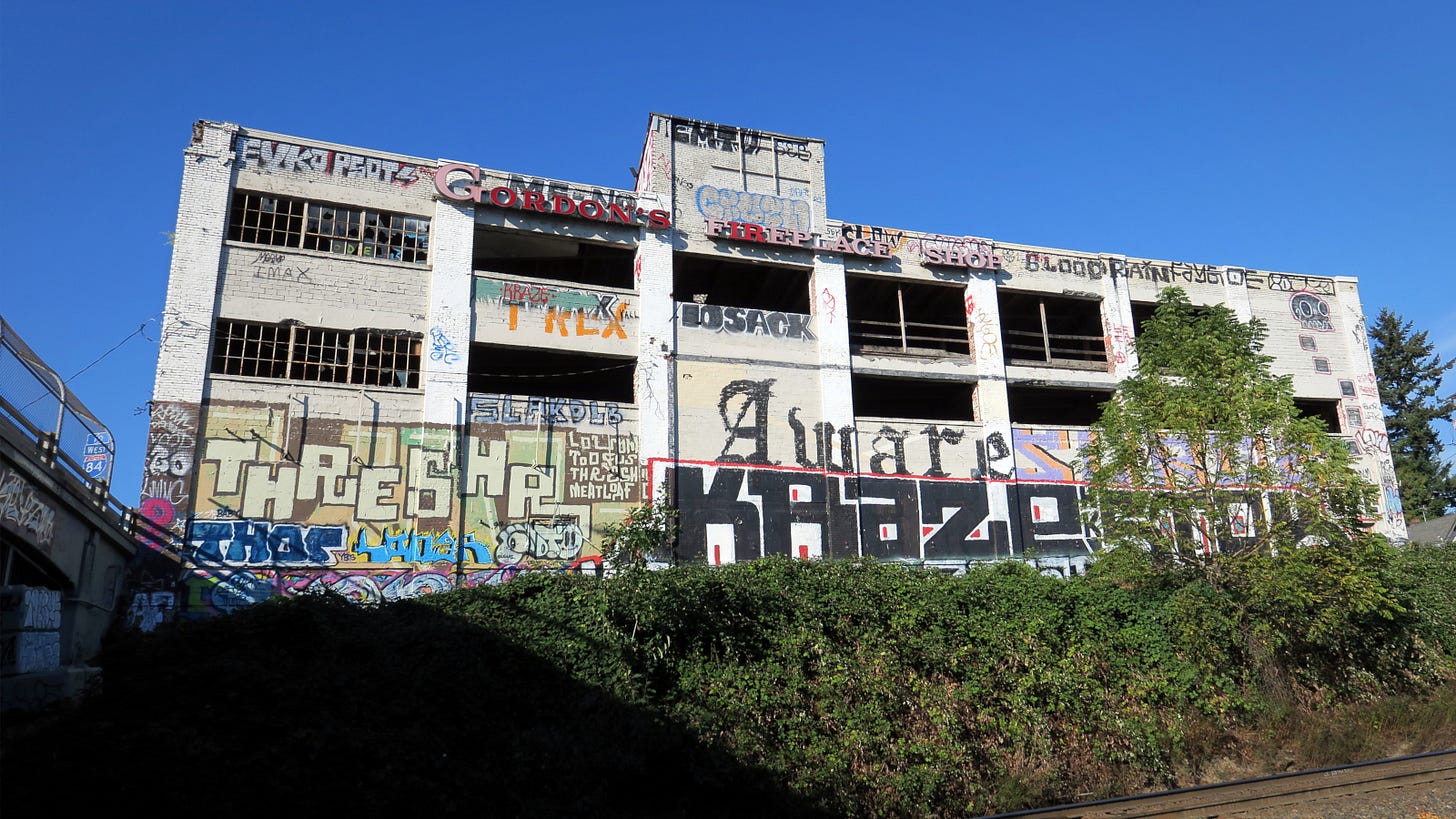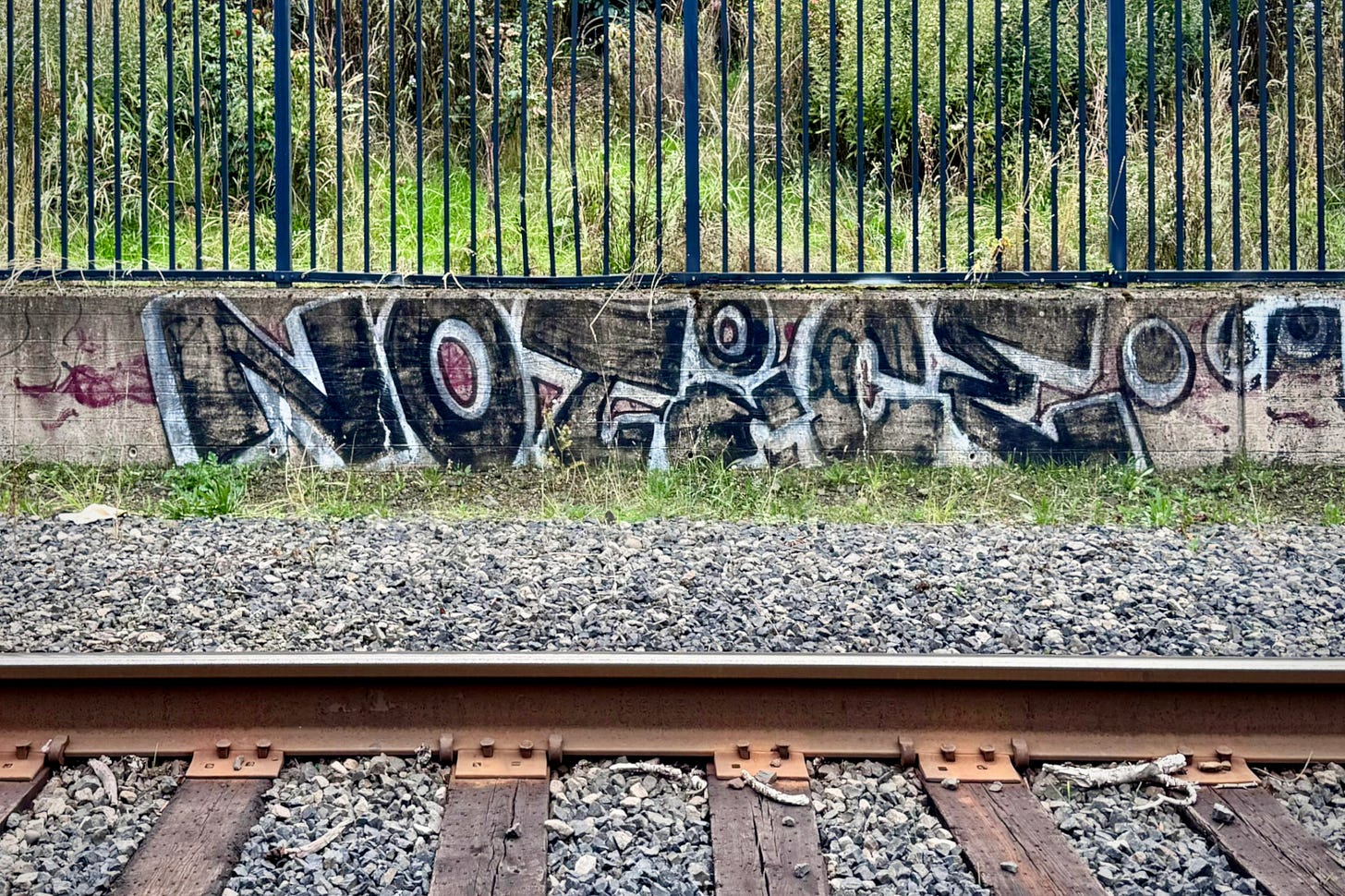Cloudy bright
“You with the news?” someone called out.
Cutting through the empty lot next to the old Gordon’s Fireplace building, I’d walked past a late model sedan with tinted windows and now the driver was quizzing me. Warm Polo air drifted over the passenger window and lingered in the brisk air I’d been shooting in.
“I’m making a short film,” I said. “On a graff writer, Notice,” I added, rubbing my hands together, glancing towards my car.
“They talked about using the building to put up the homeless,” he said, about Gordon’s. “Excuse my language, but it’s thirty f**kin’ degrees.”
“Wow, yeah, it’s bad. I passed some campsites down below,” I said, motioning to the tracks. A reimagined Gordon’s flashed through my mind, graff intact, residents happy and warm.
“I saw the camera and thought maybe you was with the news.” I shook my head. “Notice, where’s he from?” he went on.
“I’m not sure, he’s all over—Atlanta, New York, Paris, here.” My attention returned to the camera at my side that held a record of the past hour down by the tracks.
They replaced the chain-link around Gordon’s, so I’d walked a couple blocks east down Broadway and found an unfenced section. The sky was cloudy bright, just right for shooting. Crouched low on the embankment near an abandoned fast-food place, I watched a freight train snake silently through the gulch until the clattery caboose, a veil of slender trees separating us. High steps had been formed in the earth from those who scaled the story-high bank before me and looked like a clay sculpture, rounded and modern. I glanced at the parking lot behind me and then made my way down, holding onto shrub branches to keep from sliding. Had I seen Rango on one of the cars? Rango, Rango all up and down the I-5. Artist for the commuter. Rango, one of the true ones. A Portland commissioner is pushing jail sentences for writers, and they’ve already gone over lots of tags and pieces in start-fresh grey, but Rango doesn’t stop.
As I reached the gravel, I noticed a blue tarp-tent in the brush a couple yards away, still and quiet. I kept my footsteps light, dodging iced coffee containers and a flattened Cheez-its box. Globs of soggy tissue dotted the ground like melting snow. An overturned baby carriage told a dark story. My gaze was then drawn upwards to the overpass, where a weathered Area piece shone like an apparition. All red and yellow and striking, it was more angular and serious than the throwies my camera and I chased all over town the past couple years—like the stakes had been different or something. I lingered on it for several moments and then walked on, glad it was protected from view.
Gordon’s Fireplace Shop occupied a century-old three-story building in Northeast Portland and closed down several years back. Now tended only by writers and the occasional onlooker or hungry investor, the building still sits grandly over the I-84, forgotten in the bustling city—a paradox, or to some, a paradise.
Pummeled by a hundred years of rain, sun, and snow, its walls are crumbling. Bricks or shards of glass sometimes plummet to the ground. Human patrons have been replaced by crows making roomy nests in its upper floors. I find the ruined exterior beautiful: graff-covered walls make mysterious statements like RANCHLET’S or AWARE. Layers and layers of paint. Whose words and works could be underneath? On a sleepless night once, it beckoned me from across town at 4 a.m. and as I approached in my car, I could peer through its busted-out windows and see a new ghostly light from the street behind.
Being down in the gulch was different: an oasis wrapped in an indifferent city. Solitude and communion. Trust and wariness. Tranquility and vibrancy. Decay and fresh paint. The only other time I’d been down, the sky had been bright blue and there were three writers and a couple wanderers. I’d slipped through the hole in the old fence, and the writers seemed as surprised as I was as I jumped from the last plateau to the ground next to the underpasses. A skinny shirtless guy with baggy jeans and a mop of dark curly hair seemed in charge. I pointed to my camera then up at Gordon’s and made the okay sign to let them know I had business of my own and wasn’t there to make trouble.
Soon after I’d started working, the leader came over and asked what I was doing there. Sometime in my thirties I’d learned that for reserved people, operating a camera came with two sides of a social coin: a sense of license and sometimes the curiosity of others—it made me open up. I explained about the film.
Later, when I climbed back up, the writers weren’t far behind.
“I heard they’re really cracking down,” I said.
“They always say that,” the leader said. “I’ve been doing this since sixth grade. They can’t stop us.”

This time, my only company was the light rail trains whirring past, blocking out the I-84 din a few seconds at a time, and the crows eyeing me between flights from their graff-covered loft. There’s lots of energy. Freedom of expression.
Skipping odd ties, I took the tracks back toward Gordon’s to the underpasses, vigilant, hopeful I’d get the missing piece for my sequence.
Time fell away.
Gravity by ALI the GREAT, 2024
“Are you making it for Notice?” the stranger in the car was asking.
“It’s for me,” I smiled, telling him goodbye. Maybe I could make it to the Union Pacific yard while the light was still good.
Pick your king
‘Poison Idea’. Every few weeks for a couple years during the 80s, my mom would pick me up early from school and drive me downtown to get my braces tightened. Rushing down I-84 in the mid-blue Volvo my dad had passed on to her when he got the Firebird, there wasn’t much conversation, just Lionel Richie or Barry Manilow coming from the radio seeming to want to soothe us. I’d gaze out the window taking in words scrawled on the overpasses flying past and see that phrase, sometimes with a line drawing of a lightbulb. I liked how it looked and how the two words clashed a little. I wondered who did it, and how, and imagined what they could be trying to say. At some later point I learned Poison Idea was a punk band that played at clubs like the Satyricon, not far from the orthodontist’s office. It’s the first graffiti I can remember—like really seeing—and it ignited my imagination in ways school couldn’t. Maybe it was emblematic of a certain level of noticing—that double-edged sword.
Pick Your King E.P. by Poison Idea, 1983 Fatal Erection Records
In the 90s, I flipped for the film version of Stephen King’s CHRISTINE (John Carpenter, 1983). Cute loner Arnie, his transformation, and the restoration of that ‘58 Plymouth Fury was an irresistible combination. But the believable way that car came alive—right from the factory line—made anything seem possible in the realm of imagination. In the early 2000s, Robert Wise’s THE HAUNTING (1963) and the low-budget CARNIVAL OF SOULS (Herk Harvey, 1962) captivated me. All of these told stories of people reckoning with some adversity and drawn into unlikely, sometimes perilous, connections. A car, a mansion, a church organ—they depicted degrees of the inanimate coming to life. Degrees of power over people drawn to them. Power that could drive or devastate.
Let My Record Rotate by Mr Brady, prod. Rob The Viking, 2003
Breath of life
A year or two back, I was struck by how cool The Haunting’s dialog and sound would be for the story of a woman both entranced and driven a little mad by graff. Dominating the story is the omnipresent NOTICE. Watch how the lettering is its own character. The heroine is right: It’s alive. I can’t see most writers in the act, and some create the illusion of being everywhere all at once, like an invisible force. Writers breathing life into letters—just like with beats or tracks or frames of film—can awaken my imagination. I dwell where they dwell or watch their work whiz past the car window like a movie and then make new stories or reimagine familiar ones.
In NOTICED, it isn’t revealed who—or what—she is, but through her eyes, encounter MITTS, EYOR, DAYZE of Paris, CKRET, PARLE, WINKS, SERAF... and lots of others at a closer look: SURGE, SWAPS, ALFREIGHTO... Noticing determined her fate.
NOTICED, 2024, Filmed and edited by Dana. Sound: The Haunting (Robert Wise, Humphrey Searle, 1963 Metro-Goldwyn-Mayer). Duration: 10m
By Dana: writer | photographer | self-taught filmmaker. Portland, Oregon.







